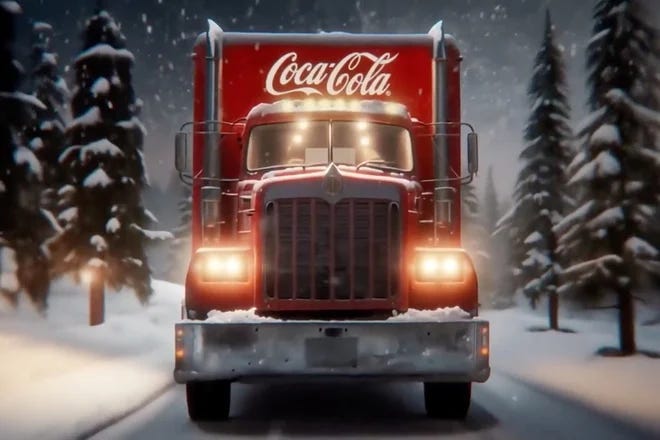54. New Sounds Never Before Heard
Coca-Cola talks AI intent and results.
HEADLINES
** AI creates never-before-heard sound
Nvidia’s Fugatto AI can make a trumpet bark or a saxophone meow
Researchers have developed an AI audio generator that they claim can create sounds that have never been heard before.
The new generative artificial intelligence model, called Fugatto, was built by a team at computer chip giant Nvidia who wanted to create a “Swiss Army knife for sound”.
** Illuminate
Transform your content into engaging AI‑generated audio discussions
Illuminate is another Google “Experiment.” This offers a number of scenarios where you can choose two different AI voices, upload your content, and Illuminate generates an extemporaneous “podcast-like” conversation. I find it a step back from their NotebookLM project. You get two voices, and they are far more human than Illuminate. Check out my podcast of this edition for proof.
** Give me an ”E”
A 280-page novel without the letter “E” exists
Gilbert Adair's translation of Georges Perec's, "A Void" is a linguistic marvel—a detective novel written entirely without using the most common letter in the English language. This extraordinary feat demonstrates the remarkable creativity possible within strict literary constraints, transforming a potential limitation into a captivating narrative challenge.
However, I spy eight “e’s" on the cover. Make that nine if you include the publisher’s name on the binding. Seems like cheating to me.
- via Mindstream
FEATURE
Source: Ad Age Nov 22, 2024
Coca-Cola Responds
Coca-Cola's recent holiday marketing campaign represents a significant case study in the emerging mash-up of artificial intelligence and brand communication strategies. The campaign, which leveraged AI-generated content across multiple commercial productions, has sparked a nuanced discussion about the role of generative AI in creative industries.
The campaign's core innovation was the creation of three separate AI-generated commercials reimagining Coca-Cola's iconic 1995 "Holidays Are Coming" advertisement. Produced by three distinct AI studios - Secret Level, Silverside, and The Wild Card - the project serves as a practical exploration of AI's current capabilities in video content creation.
Pratik Thakar, Coca-Cola's VP and global head of generative AI, positioned the campaign as a strategic technological experiment rather than a wholesale replacement of human creativity. His commentary reveals a measured approach to AI integration, emphasizing that the technology is a tool to enhance, not eliminate, human creative processes.
Key Analytical Observations
These emerge from the campaign and Thakar's subsequent interview:
Technological Capability Assessment
The AI-generated commercials demonstrate the evolving sophistication of generative video technologies. While not perfect, they represent a significant milestone in commercial-quality AI video production. The campaign highlights both the potential and current limitations of AI-driven content creation.Consumer Perception Research
Coca-Cola's extensive research in North America and Europe revealed an intriguing consumer response. Contrary to industry fears, consumers appeared more focused on narrative and entertainment value than the technological means of production. This suggests a potential paradigm shift in audience expectations and technological acceptance.
Strategic Implementation
The brand's approach was notably deliberate. Thakar emphasized that AI deployment is not universal but contextual. The holiday campaign's "fantastical, hyper-realistic storyline" was specifically chosen to leverage AI's strengths, indicating a nuanced, strategic approach to technological integration.Industry Reaction Dynamics
The campaign exposed the complex landscape of AI adoption in creative industries. Responses were polarized, with some viewing it as innovative and others as potentially threatening to traditional creative roles. And some saw this as killing off Santa. This reflects broader societal debates about AI's impact on employment and artistic expression.Transparency and Narrative Control
Thakar acknowledged a potential communication gap, suggesting that more proactive storytelling about the AI process might have mitigated negative reactions. This reflects an emerging challenge for organizations implementing transformative technologies: managing public perception and understanding.
Methodological Considerations
The campaign involved real actors and original music composition
Human creatives remained central to decision-making processes
AI was positioned as a collaborative tool, not a replacement
Comparative Context:
The approach mirrors previous technological transitions in marketing, such as the introduction of computer-generated imagery (CGI) in the early 1990s. This suggests a pattern of technological integration where initial skepticism gradually transforms into accepted practice.
Limitations and Future Implications:
While the campaign demonstrates AI's potential, it also reveals current constraints. The technology still requires significant human intervention, and the quality of output remains variable. Future developments will likely focus on refining generative capabilities and improving human-AI collaboration.
Summary (and then we’re done with this topic)
The Coca-Cola AI holiday campaign thus emerges not as a revolutionary disruption, but as a calculated exploration of emerging technological capabilities. It represents a measured step in understanding how generative AI can be strategically integrated into established creative processes.
The broader significance lies not in the specific campaign, but in what it reveals about organizational approaches to technological innovation: a balanced, experimental methodology that seeks to augment rather than replace human creativity.
Source: Ad Age Nov 22, 2024
If you find this edition of value please feel free to leave a note in the comments. And if you’re so inclined, you can now even buy me a cup of coffee.☕️☕️☕️☕️☕️
Please help share this far and wide:
Like this post!
Re-stack it below!
Share this post on Substack and other social media sites:
Feedback is always helpful.
Thanks for the read!
-pb









